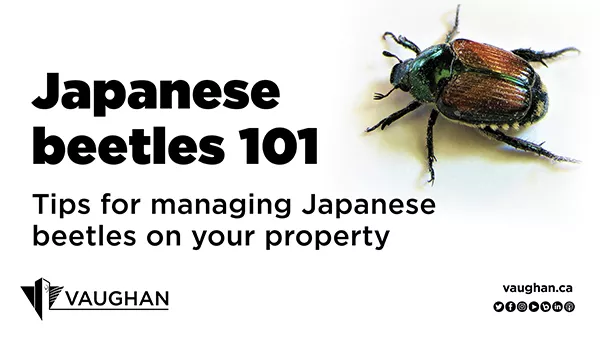Japanese beetles 101
Tips for managing
Japanese beetles on your property
This summer, residents may be seeing Japanese beetles throughout the community. These insects are an invasive plant pest commonly found on trees, shrubs and in gardens. They are destructive both as adults and larvae. Adult beetles are heavy feeders and eat the tender tissue between the veins of the leaves of plants, leaving behind brown, skeletal remains. The City of Vaughan is not treating for Japanese beetles at this time as they are generally not fatal to plants or turf and are not classified as forest pests.
What are Japanese beetles?
The Japanese beetle is native to the main islands of Japan and was first discovered in North America in southern New Jersey in 1916. There is only one generation per year. Adults appear in the summer and are very active for about six to eight weeks. Their normal life span is 30 to 45 days. The female deposits up to 60 eggs about eight centimetres deep in soil of lawns and other grassy areas. The eggs hatch in about two weeks and the small larvae begin to feed on grass roots. After a resting period of approximately two weeks, the larvae will then emerge as adult beetles in late June or early July.
This summer, residents may be seeing Japanese beetles throughout the community. These insects are an invasive plant pest commonly found on trees, shrubs and in gardens. They are destructive both as adults and larvae. Adult beetles are heavy feeders and eat the tender tissue between the veins of the leaves of plants, leaving behind brown, skeletal remains. The City of Vaughan is not treating for Japanese beetles at this time as they are generally not fatal to plants or turf and are not classified as forest pests.
What are Japanese beetles?
The Japanese beetle is native to the main islands of Japan and was first discovered in North America in southern New Jersey in 1916. There is only one generation per year. Adults appear in the summer and are very active for about six to eight weeks. Their normal life span is 30 to 45 days. The female deposits up to 60 eggs about eight centimetres deep in soil of lawns and other grassy areas. The eggs hatch in about two weeks and the small larvae begin to feed on grass roots. After a resting period of approximately two weeks, the larvae will then emerge as adult beetles in late June or early July.
What
can homeowners do?
Prevention and early control are important. Here are some tips homeowners
can use on their property:
- Hand pick and dispose of the first beetles you see, usually in late June and July. These first beetles send out chemical pheromones that attract more beetles to the area.
- Plant non-attractive plants such as arborvitae, baby’s breath, begonia, bleeding heart, buttercups, columbine, catnip, chives, garlic, tansy, daisies and flowering dogwood.
- Use a soap-water spray (one part liquid soap to 40 parts water). This mixture works best when the beetles are present in small numbers.
- Try pheromone traps. These can be used to attract the beetles and allow you to dispose of them offsite. These are available at most nurseries and big-box retail stores.
A
combination of methods is often the best approach to treat the Japanese beetle,
as it is important to treat them early and repeat the treatment method(s)
often.
If
you have concerns about plants on your property, contact a plant care
professional. For materials and supplies, contact your local nursery or garden
supply store.
-30-

